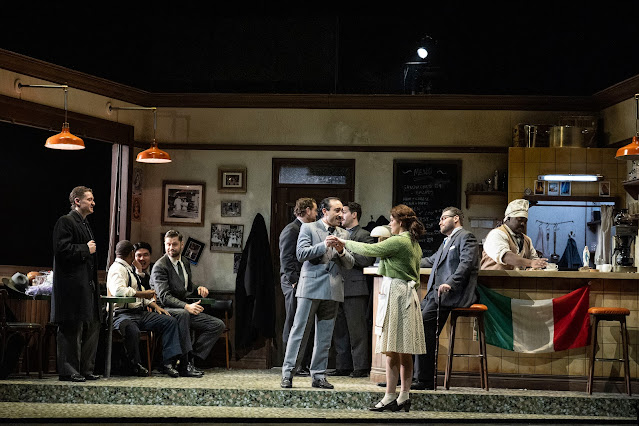 |
| Bellini: The Capulets & the Montagues – Brenton Spiteri, Jessica Cale, Masimba Ushe – English Touring Opera, 2025 (Photo: © Richard Hubert Smith) |
Bellini: The Capulets and the Montagues; Jessica Cale, Samantha Price, Brenton Spiteri, Timothy Nelson, Masimba Ushe, director: Eloise Lally, conductor: Alphonse Cemin, English Touring Opera; Hackney Empire
Reviewed 22 February 2025
A 1950s Mafia based account Bellini’s star-crossed lovers imbued with magic thanks to engaging and stylish soloists, along with a strong musicality for the ensemble
Following the failure of his opera Zaira in Parma in 1829, and the resultant straining of Bellini’s relationship with his librettist, Felice Romani, the composer found himself without a contract for a new opera. In Venice, for Carnival performances of his opera Il Pirata, he ended up taking up a contract for a new opera when it became apparent that the planned composer, Pacini, was not going to be able to deliver.
The new work had to be written at speed, something Bellini was not good at. A new Bellini opera was ‘reassuringly expensive’ because the composer prided himself on the time he devoted the writing. In this case, Romani quickly reworked an existing libretto, originally written for Giulietta e Romeo by Niccola Vaccai which premiered in Milan in 1825. The original source was an Italian play of 1818, based on a source related to that Shakespeare used. Not only was the libretto based on existing material, but Bellini reused material from Zaira as well as lifting two arias from his first opera, Adelson e Salvini (written for the conservatoire in Naples, but never professionally performed).
The new opera was a success, sealing Bellini’s fame, and it was performed at La Scala, Milan the following season. However, during the 19th century Bellini’s opera remained inextricably linked to Vaccai’s. In 1832, Maria Malibran performed the role of Romeo in Bellini’s opera but asked for the final scene to be replaced by the corresponding scene in Vaccai’s opera. This became common practice in Italy during the 19th century, making the mezzo-soprano role of Romeo more accessible to contraltos.
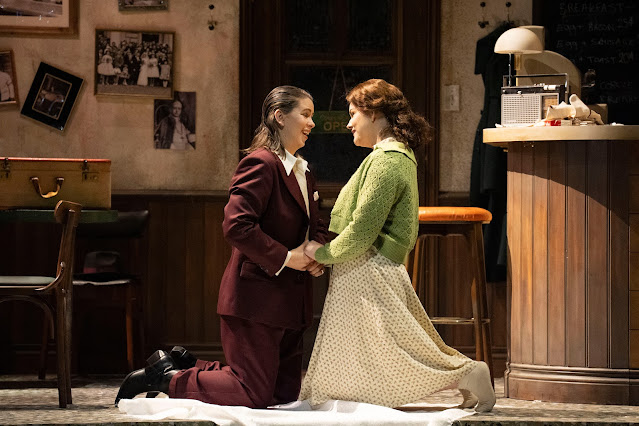 |
| Bellini: The Capulets & the Montagues – Samantha Price, Jessica Cale – English Touring Opera, 2025 (Photo: © Richard Hubert Smith) |
It is a relatively compact work, focused strongly on the two lovers and with a plot that, though differing somewhat from Shakespeare, requires little explanation for audiences. As such, it is a relatively popular choice with opera companies seeking a Bellini opera for performance.
Covent Garden’s 1984 production of the work (last seen in 2009), designed and directed by Pier Luigi Pizzi, is the only one I have seen to stage the work in the original setting and most companies opt for an updating, transposing the violence to more modern gangsters.
English Touring Opera‘s Spring season is taking Shakespeare as its theme. Alongside a new studio work, What Dreams May Come using settings of the playwright’s texts by diverse composers and a new opera by Michael Betteridge, The Vanishing Forest, aimed at children, the company is touring its production of Bellini’s Capulets and Montagues directed by Eloise Lally [who directed the company’s 2023 production of Donizetti’s Lucrezia Borgia, see my review].
We caught the opening night at Hackney Empire on Saturday 22 February 2025. The conductor was Alphonse Cemin [whom we heard as pianist earlier this year accompanying baritone Julien Van Mellaerts in his music exploration of a Paris cemetery at Wigmore Hall, see my review], with Jessica Cale as Giulietta [Poppea in ETO’s 2023 production of Monteverdi’s L’incoronazione di Poppea, see my review], and Samantha Price as Romeo (she sang the title role in G&S Iolanthe at ENO in 2023, see my review), plus Brenton Spiteri as Tebaldo, Timothy Nelson as Capellio and Masimba Ushe as Lorenzo. The orchestra was admirably full, with 12 strings, double woodwind, single brass, timpani and harp, plus an choral ensemble of seven men.
Eloise Lally and designer Lily Arnold chose to lean into 20th century iconography for the work with Martin Scorsese’s film Mean Streets and the Mafia photographs of Letizia Battaglia as inspiration. The result removed the grand sweep of the work and replaced it with narrow focus on an Italian-American crime family based out of a neighbourhood, ‘Mom & Pop’ café. Whatever empire he once had, Timothy Nelson’s Capellio was clearly on his last legs.
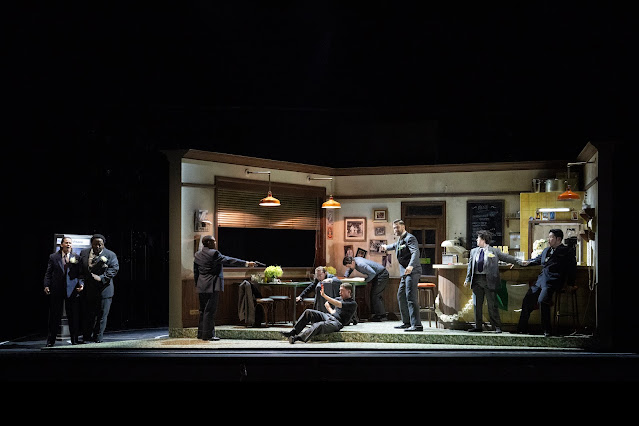 |
| Bellini: The Capulets & the Montagues – Samantha Price, Masimba Ushe – English Touring Opera, 2025 (Photo: © Richard Hubert Smith) |
Visually, the piece leaned into the 1950s but not quite strictly and the hyper-realism of the Act One set was contrasted with a very visible lighting rig. This sense of disconnect increased in Act Two where the permanent set was the outside of the cafe, now ruined after the violence, with Giulietta’s tomb more a catafalque created on the remains of the bar. Again, with lighting rig quite visible.
Realism simply is not possible in the work, because for the fighting that closes Act One, Bellini’s creates music with a large-scale expansiveness that contrasts with the short brutish reality of a fight. Here fight director Kaitlin Howard and movement director Carmine De Amicis crafted something based around slow-motion that was largely effective though occasionally threatened to veer into risibility, but never quite did.
What lifted the work was the sheer quality of the musical performances with the two lovers presented with both passion and stylistic confidence, complemented by some instrumental solos that were very fine indeed, notably the horn solo for Giulietta’s opening aria and the later clarinet solo in Act Two.
Jessica Cale’s Giulietta was present from the beginning, the opening scene showing the way Capellio’s men talk about her, even in her presence. Her opening solo might have lacked the moonlight magic from a more traditional staging, but ending up prone on the bar, Cale brought real magic to Giulietta’s vocal line, partnered by the fine solo horn. There was a delicacy to Cale’s approach, but she had the right way of filling the vocal line that is needed in this music. Whilst her solo at the opening of Act Two was equally poignant, this Giulietta displayed a certain steely resoluteness whenever Samantha Price’s Romeo urged her to abandon everything and simply flee.
Samantha Price made a handsome, highly vigorous hero, her physicality really leaning into the role and was a muscular sense to match in the music. She provided fine contrast in Romeo’s first double aria, with remarkable tenderness in the cavatina (lamenting his killing of Capellio’s son) but then impressive muscularity, allied to fine style, in the cabaletta. The second scene of Act Two opened with an orchestral introduction (with fine clarinet solo) that led to a powerful account of one of the opera’s finest moments, Romeo’s bitter recitative, and in the final Price was on strong form in Romeo’s solo.
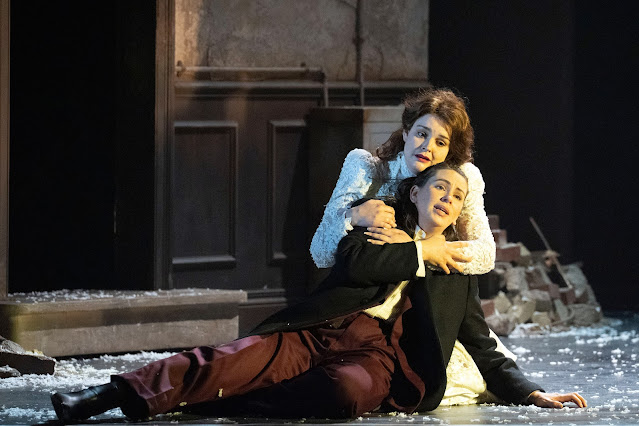 |
| Bellini: The Capulets & the Montagues – Samantha Price, Jessica Cale – English Touring Opera, 2025 (Photo: © Richard Hubert Smith) |
Yet it was the interaction of the two, Cale and Price, that really set the drama alight. Their duet in Act One, ending up prone on the floor, bringing out a sort of intense magic whilst the final scene managed to be touching and musically inspiring whilst avoiding the sense of the risible that can dog the sort of death scene.
But Price had another duet, also in Act Two, as her Romeo faced off with Brenton Spiteri’s Tebaldo. This also created a nice sense of tension, yet with both singers remaining within the work’s musical outlines, no exaggeration for effect here. Earlier in the opera Spiteri had proved a stylish and surprisingly sympathetic Tebaldo, his opening aria including some lovely ornamentation in the repeat.
Timothy Nelson’s Capellio lacked the essential fierceness that can animate the role. Nelson sang with rather soft-grained tone and whilst his performance was musical, we wanted a greater feeling of innate strength. Masimba Ushe’s Lorenzo, here the cafe’s barman and gopher, was a strong and sympathetic presence as Ushe managed to make much of Lorenzo’s relatively small part.
Mention should be made of the hard working chorus (who at one point have to supply both Montagues and Capulets). Whilst they had to be highly active in the fight scene, elsewhere Bellini gives the chorus moments when they can pause and simply enjoy the music, and here the six men gave us some really fine choral ensembles.
In the pit, Alphonse Cemin seemed at first determined to keep the pace, and indeed his traffic policeman role in the big, active ensembles, was well done but in the more reflective music he did allow time to breathe. There was a sense of active impulse throughout and you feel that this is an interpretation that will bed in finely (there are 12 more performances to come). The came can be said of the orchestra, and you sense the fine solo moments coming together to form a whole.
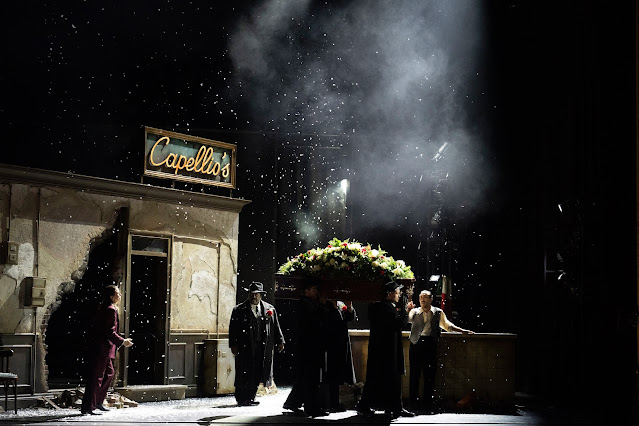 |
| Bellini: The Capulets & the Montagues – Samantha Price, Masimba Ushe, Brenton Spiteri – English Touring Opera, 2025 (Photo: © Richard Hubert Smith) |
Frankly, I am not sure what Eloise Lally’s concept really added to the opera and I would have preferred something more abstract, as the elements of hyper-realism did not quite connect with Bellini’s music. But she undoubtedly drew fine performances from all her cast so that the production’s high level of musicality was aided by a real sense of drama.
The blog is free, but I’d be delighted if you were to show your appreciation by buying me a coffee.
Elsewhere on this blog
- Two violas: Peter Mallinson on exploring the surprisingly fertile ground of music for two violas with fellow viola player Matthias Wiesner – interview
- Real musical riches: Thea Musgrave’s Mary, Queen of Scots returns to the UK after an embarrassing period of neglect – opera review
- Philip Glass Festival: the Hallé & Royal Northern College of Music proudly mounted a three-day mini-festival – concert review
- Reclaiming Love: An Alternative Valentines Song in the City’s contribution to LGBT History Month including rare Smyth & Grieg plus Brahms’ Love Song Waltzes – review
- An enormously intense, personal experience: composer Michael Zev Gordon on writing A Kind of Haunting, his new piece inspired by his family’s experience of the Holocaust – interview
- Letter from Florida: It is hard to imagine any orchestra getting closer to playing as one, though, than The Cleveland Orchestra – concert review
- A woman on the edge: Cherubini’s Médée in the original French version yet given a powerful modern twist with Joyce El-Khoury – opera review
- To create modern culture through the thoughts of the past: George Petrou artistic director of the Göttingen International Handel Festival introduces this year’s festival – interview
- Another crazy day: Joe Hill-Gibbins’ production of Mozart’s The Marriage of Figaro returns to ENO reinvigorated – opera review
- My Heart’s in the Highlands: the debut recital from tenor Glen Cunningham mixes Stuart MacRae’s new songs with other composers with ‘Scotland in Mind’ – record review
- Home


,%20Jessica%20Cale%20(Giulietta)%20(c)%20Richard%20Hubert%20Smith.jpg?w=998&resize=998,665&ssl=1)





